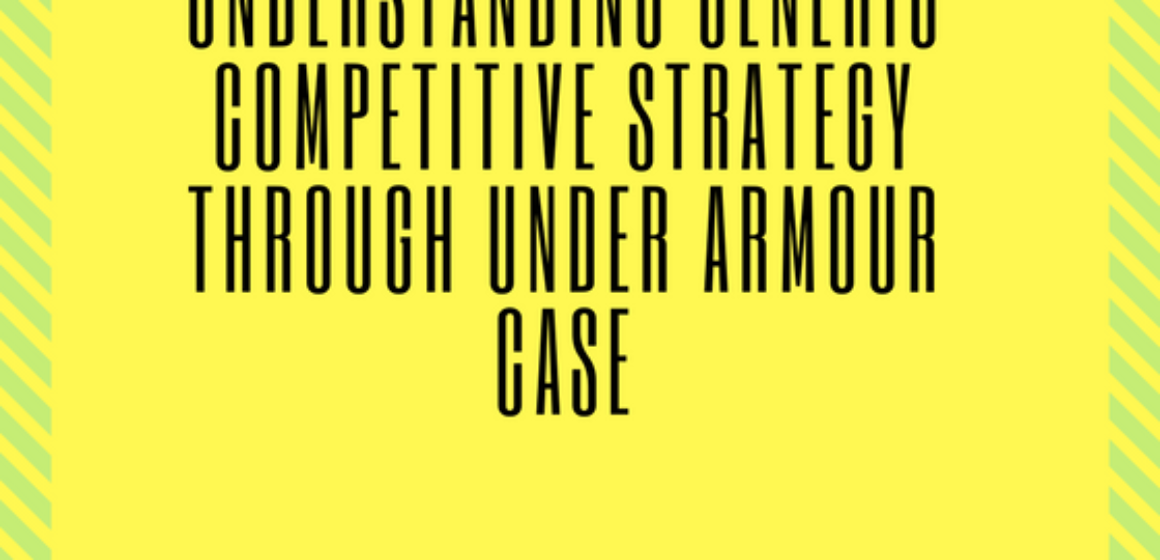Under Armour Case: Generic Competitive Strategy
Introduction
Companies can employ a limitless number of competitive strategies as the strategic approach of the company entails custom-designed approaches which can fit the company’s own circumstances and the conditions which are prevalent in the market. However, the major differences among the competitive strategies adopted by companies boil down to (1) whether the company is targeting the broad market or a small part of it (2) whether the company is pursuing competitive advantage linked to low costs or product differentiation. A total of three different competitive strategies standout: cost leadership, differentiation, and focus/niche strategy.
Generic Competitive Strategy in Under Armour Case
In order to survive in the highly competitive sports industry, Under Armour followed the differentiation strategy. Focusing on the cost leadership and focus/niche strategy could have limited its growth options. Right from the time Under Armour was founded, the company focused on building a competitive advantage in the market by coming out with T-Shirts which can control the temperature of the body. Under Armour didn’t focus on coming out with lower cost alternatives to the existing products which are made by other players in the market like Nike and Adidas. Instead, it focused on coming out with innovative products which are different from the products which are offered by other players. In other words, Under Armour followed a differentiation competitive strategy and came out with products which are perceived as unique by the industry as the whole. Firms try to differentiate themselves from other players in the market through a number of means. In the case of Under Armour the key approach to differentiation is through the invention of new technology. Under Armour’s founder developed a new way of making climate control T-Shirts through high-tech material which is also cut to make it feel like second skin. This innovative technology is made available to the consumers through a number of product lines targeted at different groups of consumers like men, women, and youth. Innovative technology aspect in the supply chain helped in the marketing activities of the firm by allowing it position itself as a brand which produces unique products.

Another important in which Under Armour tried to differentiate itself from its competitors is by coming out with innovative designs. As 80 percent of sports products are used for non sports use, Under Armour’s products are released in three fits, tight fit, relaxed fit, and athletic fit which is unique for a sportswear brand. This made its climate control apparel more useful for a broader range of customers than athletes. Under Armour also recognized that needed to keep its products and designs fresh and attractive for attracting more number of customers. Hence it started to recruit more number of people from top grade US fashion schools. Sports apparel which looks more fashionable will appeal to the eyes of young and hence effectively differentiates the products of the company from the others. Recruitment of skilled human resources too helped in the marketing and sales part of the firm’s value chain.
On the branding front, firms can differentiate their products from that of their competitors by creating a unique brand image. Under Armour positioned itself as a supplier of unique products which help athletes to perform better. For this purpose, it focused heavily on celebrity endorsement and product placements. Under Armour identified rising stars in different sports and signed multiyear contracts with them. This helped the firm to give a good exposure to consumers through multiple marketing channels like Internet, magazines, and sporting events. As mentioned in the case, the marketing team of Under Armour focussed on sponsoring recreational teams and major youth tournaments which help to build a favourable brand image by driving awareness and brand authenticity at the basic level. As other leading brands like Nike and Adidas mostly focused on sponsoring bigger teams, sponsoring small university and recreational teams created a differentiated brand image for Under Armour.
As per the Barney’s criteria (1991) for building competitive advantage, companies can build a sustainable competitive advantage by building on its internal and external strengths and neutralising external threats. Under Armour built on its unique strengths of new to the market technologies and innovative marketing ideas. Under Armour built a sustainable competitive advantage by building on both its tangible resources like technology and management systems as well as intangible resources like creative marketing ideas and efficient human resources. Leveraging on these strengths it adopted a differentiation strategy in a market dominated by big players. As per barney’s criteria, the combination of resources should lead to a unique capability which in turn leads to core competency and competitive advantage. In the case of Under Armour, the combination of superior technology and innovative marketing strategies lead to the capability to come up new product ideas. This unique capability leads to the core competency of producing new to the world products like climate control T-Shirts which gave it the competitive advantage of differentiating from its competitors. These factors helped it to neutralize its internal weaknesses like being a new player in the market and limited advertising and promotional budgets.
Like this paper? This is a sample paper written by one of our writers. Academic Mentor Online’s professional essay writers specialize is case analysis. Contact our support department to know more about our cheap essay writing service which is high on quality.
